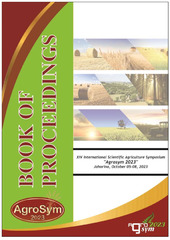Приказ основних података о документу
THE INFLUENCE OF COVER CROPS AND MICROBIOLOGICAL FERTILIZER ON YIELD AND YIELD COMPONENTS OF SWEET MAIZE (Zea Mays L. sacharata Sturt)
| dc.creator | Dolijanović, Željko | |
| dc.creator | Šević, Biljana | |
| dc.creator | Simić, Milena | |
| dc.creator | Dragičević, Vesna | |
| dc.creator | Đorđević, Snežana | |
| dc.creator | Đurić, Nenad | |
| dc.date.accessioned | 2024-01-09T12:01:08Z | |
| dc.date.available | 2024-01-09T12:01:08Z | |
| dc.date.issued | 2023 | |
| dc.identifier.isbn | 978-99976-816-1-4 | |
| dc.identifier.uri | http://aspace.agrif.bg.ac.rs/handle/123456789/6718 | |
| dc.description.abstract | Sweet maize, a popular vegetable, occupies an important place in the population's diet, and in recent decades, the area under this crop has been increasing. In this paper, the influence of cover crops (CC), with and without the application of microbiological fertilizer, on the yield and yield components of sweet maize (hyrbid ZPSC 421su, FAO 400) was examined. The experiment was carried out at the "Zemun Polje" Maize Research Institute during 2014/152015/16. CC consisted of four types of plants: 2 legumes: T1-common vetch, T2-field pea, 2 non-leguminous species: T3-winter oats and T4-fodder kale. Two variants with mixtures were: T5-common vetch + winter oats and T6-field pea + winter oats and two controls T7 (straw) and T8 (bare soil). CC was sown in autumn, plowed at the end of April or May, after which 1/2 of the plot was treated with microbiological fertilizer. Sweet maize was sown in mid-May at a density of 65,000 plants per ha. For industrial processing, the shape, size and uniformity of the corn cob, grain size, and row configuration are important. CC influenced the increase in the number of grain rows and the number of grains in a row, the most in the variant T4, and the weakest in the variants with mixtures (T5 and T6). The highest cob length values were measured in the T4 variant. The largest cob diameter was measured in 2016 in T4 (4.6 cm), and the smallest value in controls (3.1 cm and 3.3 cm) in 2015. By comparing the examined years, we can see that in the first year the highest yield was achieved in the T4 variant (6261.70 kg ha-1), while the lowest was achieved in the T6 variant (2732.88 kg ha-1) in the second year. | sr |
| dc.language.iso | en | sr |
| dc.publisher | University of East Sarajevo, Faculty of Agriculture, RS, B&H | sr |
| dc.publisher | University of Belgrade, Faculty of Agriculture, Serbia | sr |
| dc.publisher | ... | sr |
| dc.rights | openAccess | sr |
| dc.rights.uri | https://creativecommons.org/licenses/by/4.0/ | |
| dc.source | BOOK OF PROCEEDINGS, XIV International Scientific Agriculture Symposium “AGROSYM 2023”, Jahorina, October 05 - 08, 2023 | sr |
| dc.subject | cover crops | sr |
| dc.subject | microbiological fertilizer | sr |
| dc.subject | sweet maize | sr |
| dc.subject | yield | sr |
| dc.subject | grain | sr |
| dc.title | THE INFLUENCE OF COVER CROPS AND MICROBIOLOGICAL FERTILIZER ON YIELD AND YIELD COMPONENTS OF SWEET MAIZE (Zea Mays L. sacharata Sturt) | sr |
| dc.type | conferenceObject | sr |
| dc.rights.license | BY | sr |
| dc.citation.epage | 211 | |
| dc.citation.spage | 203 | |
| dc.identifier.fulltext | http://aspace.agrif.bg.ac.rs/bitstream/id/25548/bitstream_25548.pdf | |
| dc.identifier.rcub | https://hdl.handle.net/21.15107/rcub_agrospace_6718 | |
| dc.type.version | publishedVersion | sr |


